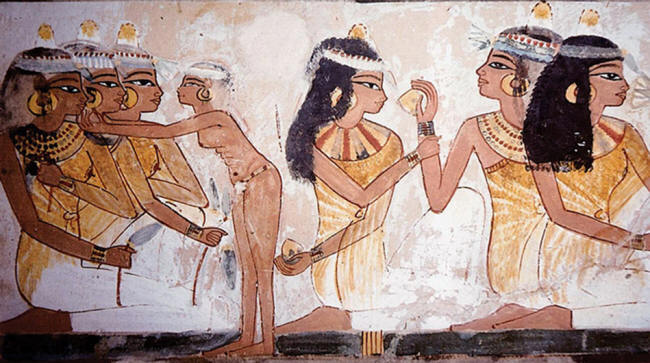|
Vol. 14 No 3 (June
2020)
But I was subsequently surprised to discover that these and other peoples achieved levels of applied science in the deep past equal to and occasionally surpassing similar material accomplishments taken for granted today.
Some important
innovations first conceived during antiquity were lost when the
civilization associated with their creation collapsed and were
completely forgotten, only to be independently re-invented thousands
of years later by modern developers utterly unaware of their ancient
precursors.
...human genius attained certain levels of technology still beyond our grasp.
So many, in fact, that hundreds of collected specimens fill the pages of my new book until their superfluity overflowed its printed limitations.
How grateful I am, then, to New Dawn for this opportunity to share with you some of the truly extraordinary instances of Ancient High Tech that missed being included in the volume so entitled!
Inca medical practitioners treated serious heart ailments with extracts of foxglove, a procedure only now acknowledged for its efficacy by 21st century
health
care professionals.
After establishing himself in the Andes Mountains, Inca tradition explained that he schooled their ancestors in the use of plant extracts from Digitalis lanata, a flower known today as "foxglove," for the successful treatment of serious heart conditions.
After the Conquistadors
overthrew Inca Civilization, its culture was entirely demonized,
along with all traditional medical knowledge, which fell into
oblivion for the next four centuries.
Its resulting compound is rated today on the World Health Organization's List of Essential Medicines as among the safest and most effective measures necessary for any health system.
But teasing digoxin from Digitalis lanata demands careful precision and observant skill because the slightest error in determining the correct amount can mean the difference between strengthening the heart or inducing cardiac arrest.
This life-and-death
discrepancy signifies that Inca physicians not only recognized its
critically narrow parameters, but themselves possessed sufficient
expertise to properly act upon such a distinction.
Only within the last thirty years has research with animals demonstrated the,
...of "wild chamomile," which is additionally included in many of today's sleep aid products.
While all this is relatively new to us, the ancient Andeans were familiar with Matricaria chamomilla and its soothing benefits long before the last Inca emperor was killed in 1533.
His culture likewise
treated
hyperlipidemia, an acquired or
genetic disorder that results in high levels of lipids; these are
fats, cholesterol, or triglycerides circulating in the blood.
The anti-cancer effects of plantago paralias are only now being gradually appreciated.
It is clear that Inca pharmaceutical and pharmacological knowledge not only far outdistanced the contemporaneous quackery of European physicians in the 16th century, but still has much to offer modern medical developments.
On the other side of the Ancient World, Nile Valley practitioners similarly undertook quantum advances in the healing arts only now coming to light.
from ancient Egyptian civilisation. The ruins on display today in modern day Egypt - although still impressive - are a pale representation of
how it
really would have looked.
The Egyptians ingested tetracycline with a special beer concoction not unlike sour porridge.
Further investigation
revealed that retrieved Roman Era samples were identical in
substance to the same beverage dating to the advent of Pharaonic
Civilization, more than three thousand years before.
Egyptian girls at a 19th Dynasty party (around 1290 BCE)
give each other different-flavored breath mints.
Their grain thus laced with tetracycline, the Egyptians observed how it cured them of various bacterial ailments, five thousand years before the discovery of penicillin by Alexander Fleming, in 1928.
Their high level of
medical science helps explain why many residents of the Nile Valley
experienced healthy longevity, such as the famous Pharaoh Ramses II,
who lived to celebrate his ninety-seventh birthday.
A toothbrush from the time of Cleopatra, last ruler of Egypt's Ptolemaic Kingdom,
circa 40 BCE.
The 4th century CE papyrus is a Greek-language copy of a traditional Egyptian invention already in common use at the outset of the 1st Dynasty, thirty-four hundred years earlier.
The original formula
calls for one drachma (one-hundredth of an ounce) of rock
salt, another drachma of mint, and one more drachma of dried iris,
plus twenty grains of pepper.
According to the sixteen hundred-year-old papyrus, all its specified ingredients should be crushed and mixed together into a,
It was discovered by Dr
Hermann Harrauer, in charge of
the papyrus collection at Vienna's National Library, in 2002, atop a
rubbish dump outside the modern Egyptian town of Al-Mahamid Qibly,
the dynastic
Imiotru, known to the Greeks as
Crocodilopolis because it housed the most prominent Early-Middle
Kingdom sanctuary (2050 BCE–1652 BCE) of the crocodile-god
Sobek.
The ancient Nile Valley cleaning agent was faithfully replicated by an Austrian dentist, Dr Heinz Neuman.
A colleague volunteered to personally test the recreation.
Anglo-American soap industrialist William Colgate began marketing the first commercial toothpaste in 1873, but it was hygienically inferior to its pharaonic forerunner, which had been lost since the Ancient Old World collapsed.
Egyptian dental care even extended to the invention of breath mints made, as recounted in a 16th Dynasty papyrus, from combining cinnamon, frankincense and myrrh, boiled together into a honey base, then shaped as small pellets for easy consumption.
Myrrh, a natural gum extracted from tree resin, is analgesic - a pain killer.
The Ancients' greatest
contribution to general health, however, was their institution of
general hygiene.
The city of in late 4th Millennium BCE was a model urban centre of ingenious water management for communal sanitation and public hygiene.
In describing the Indus Valley's earliest urban centers, US researcher David Hatcher Childress writes that
Near Baghdad, homes and sacred structures in the Sumerian city of Eshnunna (modern Tell Asmar in Iraq) featured elaborate arrangements for personal sanitation.
He goes on to quote the July 1935 issue of Scientific American magazine, explaining that the temple's plumbing equipment,
Very old as Sumerian plumping may have been, its age pales compared to a series of anomalous lead pipes inadvertently discovered inside three caves at Báigōngshān, the "White Mountain," earlier this century by paleontologists visiting China from the United States.
With an eighteen-foot-high ceiling, the largest cave features two reddish-brown pipes sixteen inches in diameter.
Outside and above its entrance, dozens of hollow pipes, some likewise sixteen inches in diameter, with others down to four inches in width, protrude horizontally from the rock face.
About two hundred sixty feet from the cave's mouth, similarly hollow formations appear on the beach of and within Lake Tuosu, protruding vertically from the water or lie just below its surface, although they differ in ranging from 0.8 to 1.8 inches diameter, and have an east-west orientation.
After the American
paleontologists shared their discovery with local authorities in the
city of Delingha, the Báigōngshān and Lake Tuosu sites were written
up in a six-part series of articles published by
Henan Dahe Bao (Henan Great
River News) in June 2002.
These dated the objects to circa 150,000 Years Before Present.
Additional testing with
different chronological methods consistently repeated the same time
parameter, until even stubborn disbelievers, such as Brian
Dunning of Skeptoid.com, in the US, were forced to concede the
pipes' Middle Palaeolithic provenance, tens of thousands of years
before homo sapiens arrived in Asia.
He wondered if iron-rich magma may have arisen from deep within the Earth, elevating iron into fissures, where it may have solidified into tubes.
He admitted his speculation was apparently negated by not only the pipes own, decidedly artificial appearance, but by their physical connection to nearby Tuosu, more convincingly suggesting a manmade function as part of some water supply system.
Moreover, their non-random, uniformly east-west alignment on the lakeshore contradicts a magmatic hypothesis.
Additional samples were further analyzed at a local smelter, where eight per cent of their material composition could not be identified.
Artistic recreation of Mexica-Tenochtitlan, the capital of the expanding Aztec Empire in the 15th century until it was captured by the Spanish in 1521. The following comment from Bernal Díaz del Castillo in his The Conquest of New Spain leaves no doubt as to the impressive achievements made by the Aztecs: "When we saw so many cities and villages built in the water and other great towns on dry land we were amazed and said that it was like the enchantments... on account of the great towers and cues and buildings rising from the water, and all built of masonry. And some of our soldiers even asked whether the things that we saw were not a dream?... I do not know how to describe it, seeing things as we did that had never been heard of or seen before, not even dreamed about."
Brushing the concealing sand aside brought to light what appears to be an Inca "funeral mask" embossed with an anthropomorphic figure surrounded by geometric designs.
Dr Torres convincingly
speculates that it was part of South American riches taken by 18th
century Spaniards who packed their looted treasure aboard a galleon
that sank in a storm. Since then, pieces driven by wave action
continue to wash up onshore.
What most sets the object apart from other such artifacts, however, is its construction from iridium, supposedly first discovered by London chemist Smithson Tennant in 1803.
It took ten more years for another British scientist, John George Children, to melt a very small sample of iridium with the aid of the most galvanic battery available at the time.
The first melting of
iridium in appreciable quantity was finally accomplished by 1860
when blast furnaces had become powerful enough for the job.
Evidence of lost high technology - this 10th century BCE Andean mask is made of iridium, the earth's second-hardest mineral, which was historically unknown until 1803 and only melted for the first time
nearly sixty years later.
As the most corrosion-resistant material known, iridium is the second-densest metal after osmium, with which it is sometimes combined in an alloy for pen tips and compass bearings.
Iridium is one of the rarest elements in Earth's crust, with annual production and consumption of only three tons.
How the Wankarani could have found, let alone identify scarce iridium - much less sufficiently melt this very high density, nearly immalleable and exceptionally hard mineral for artistic workmanship - is made all the more impossible by archaeologists' insistence that furnaces operated by pre-Spanish Bolivians never approached the extraordinarily high temperatures required to melt iridium.
Indeed, that was only achieved, as history tells us, as recently as the 19th century.
Yet, there is the Andean
mask, material proof to the contrary, and physical evidence of a
technological level unequalled for some twenty-seven hundred years.
Its further study may
tell.
|









